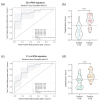Combinatorial Blood Platelets-Derived circRNA and mRNA Signature for Early-Stage Lung Cancer Detection
- PMID: 36902312
- PMCID: PMC10003255
- DOI: 10.3390/ijms24054881
Combinatorial Blood Platelets-Derived circRNA and mRNA Signature for Early-Stage Lung Cancer Detection
Abstract
Despite the diversity of liquid biopsy transcriptomic repertoire, numerous studies often exploit only a single RNA type signature for diagnostic biomarker potential. This frequently results in insufficient sensitivity and specificity necessary to reach diagnostic utility. Combinatorial biomarker approaches may offer a more reliable diagnosis. Here, we investigated the synergistic contributions of circRNA and mRNA signatures derived from blood platelets as biomarkers for lung cancer detection. We developed a comprehensive bioinformatics pipeline permitting an analysis of platelet-circRNA and mRNA derived from non-cancer individuals and lung cancer patients. An optimal selected signature is then used to generate the predictive classification model using machine learning algorithm. Using an individual signature of 21 circRNA and 28 mRNA, the predictive models reached an area under the curve (AUC) of 0.88 and 0.81, respectively. Importantly, combinatorial analysis including both types of RNAs resulted in an 8-target signature (6 mRNA and 2 circRNA), enhancing the differentiation of lung cancer from controls (AUC of 0.92). Additionally, we identified five biomarkers potentially specific for early-stage detection of lung cancer. Our proof-of-concept study presents the first multi-analyte-based approach for the analysis of platelets-derived biomarkers, providing a potential combinatorial diagnostic signature for lung cancer detection.
Keywords: biomarkers; cancer diagnosis; circular RNA; liquid biopsy; lung cancer; messenger RNA; platelets.
Conflict of interest statement
T.W. is an inventor on relevant patent applications. T.W. received financial compensation from Illumina, Inc. and is shareholder of GRAIL, Inc.
Figures






References
-
- Goldstraw P., Chansky K., Crowley J., Rami-Porta R., Asamura H., Eberhardt W.E.E., Nicholson A.G., Groome P., Mitchell A., Bolejack V., et al. The IASLC lung cancer staging project: Proposals for revision of the TNM stage groupings in the forthcoming (eighth) edition of the TNM Classification for lung cancer. J. Thorac. Oncol. 2016;11:39–51. doi: 10.1016/j.jtho.2015.09.009. - DOI - PubMed
-
- Jeon D.S., Kim H.C., Kim S.H., Kim T.-J., Kim H.K., Moon M.H., Beck K.S., Suh Y.-G., Song C., Ahn J.S., et al. Five-Year Overall Survival and Prognostic Factors in Patients with Lung Cancer: Results from the Korean Association of Lung Cancer Registry (KALC-R) 2015. Cancer Res. Treat. 2022;55:103–111. doi: 10.4143/crt.2022.264. - DOI - PMC - PubMed
-
- SEER SEER*Explorer: An Interactive Website for SEER Cancer Statistics. Surveillance Research Program, National Cancer Institute. [(accessed on 27 September 2021)]; Available online: https://seer.cancer.gov/explorer/
MeSH terms
Substances
Grants and funding
LinkOut - more resources
Full Text Sources
Other Literature Sources
Medical
Molecular Biology Databases

